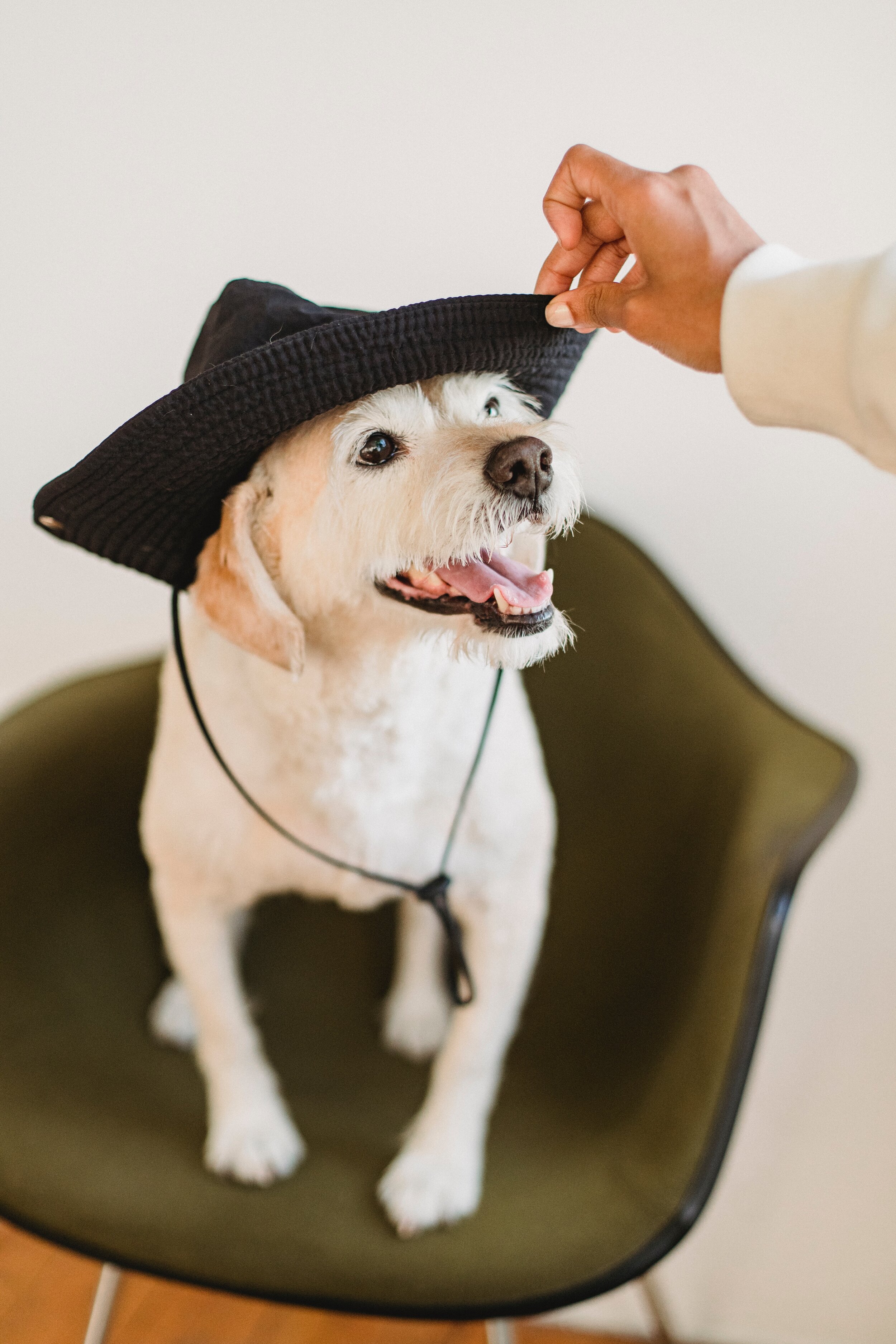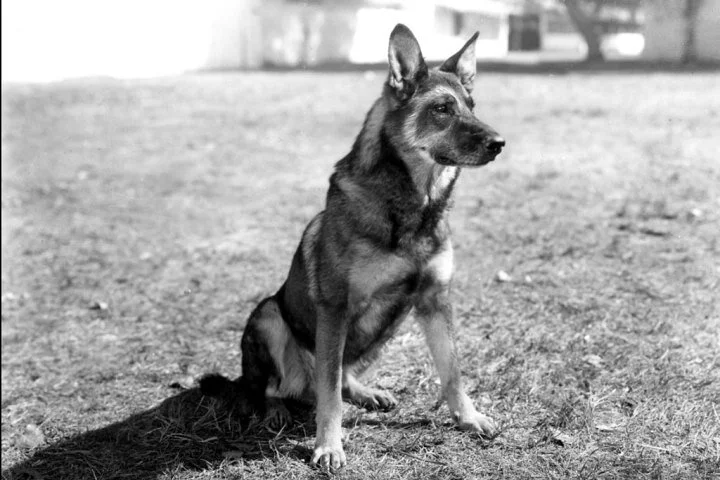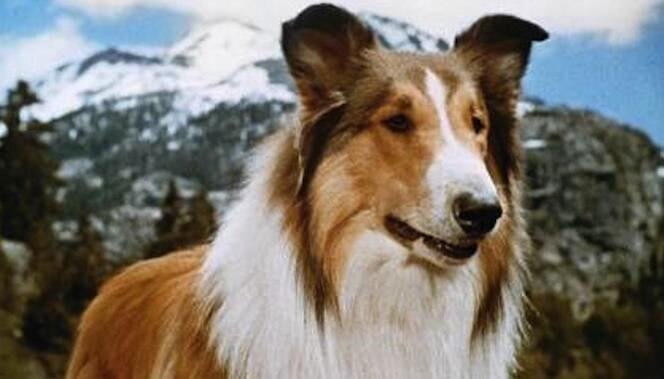The Top Five Classic Film Canines You Need to Know and Their Legacy of Puppy Love By Annette Bochenek, Ph.D.
The Top Five Classic Film Canines You Need to Know and Their Legacy of Puppy Love
By Annette Bochenek, Ph.D.
Throughout Hollywood’s Golden Age, many animals appeared in films and delighted audiences all over the world. In the case of man’s best friend, many beloved canines also happened to capture the hearts of moviegoers of all ages. While there were numerous dogs who succeeded in Hollywood, this article profiles five especially significant dogs of the silver screen.
Rin Tin Tin
1. Rin Tin Tin or Rin-Tin-Tin
(September 1918 – August 10, 1932)
Rin Tin Tin was a male German Shepherd born in Flirey, France, who became an international star in motion pictures. A beloved canine hero of the screen, Rin Tin Tin actually owed his life to American soldier, Lee Duncan, who rescued him from a World War I battlefield.
While in France, Duncan found a damaged kennel which had once supplied the Imperial German Army with German Shepherd dogs. The only dogs that happened to have survived life in war-torn Flirey were a mother and five nursing puppies. Duncan rescued the dogs and snuck them aboard a ship that took him back to the U.S. after the end of the war. Duncan, Rin Tin Tin, and his adopted sibling, Nanette II, settled at his home in Los Angeles.
Rin Tin Tin was a dark sable color and had very dark eyes. Duncan trained Rin Tin Tin and obtained silent film work for the dog, becoming a box-office success. Rin Tin Tin went on to appear in 27 Hollywood films, gaining worldwide attention. He also increased the popularity of German Shepherd dogs as family pets.
After sustaining a leg injury and recovering to full health, Rin Tin Tin had learned to leap great heights. His winning leap was filmed by Duncan's acquaintance Charley Jones, who had developed a slow-motion camera. While Rin Tin Tin’s leap was captured on film, Duncan became convinced Rin Tin Tin could become a successful in films.
Rin Tin Tin’s big break came in The Man from Hell's River (1922) featuring Wallace Beery. Rin Tin Tin would be cast as a wolf or wolf-hybrid many times, with his first starring role in Where the North Begins (1923). This film was a success and saved Warner Bros. from bankruptcy, leading to 24 more screen appearances.
Warner Bros. fielded thousands of fan letters to Rin Tin Tin. Around the world, Rin Tin Tin was popular star, easily understood by all viewers from all over the world.
Rin Tin Tin also appeared in four sound features, with Duncan guiding Rin Tin Tin by hand signals. Rin Tin Tin and Nanette II produced at least 48 puppies; Duncan kept two of them, selling the rest or giving them as gifts. Greta Garbo, and Jean Harlow each owned one of Rin Tin Tin's descendants.
In a private ceremony, Duncan buried Rin Tin Tin in a bronze casket in his own backyard with a plain wooden cross to mark the location. Duncan was suffered the financial effects of the Great Depression and could not afford a finer burial, let alone his expensive house. He sold his house and quietly arranged to have the dog's body returned to his country of birth for reburial in the Cimetière des Chiens et Autres Animaux Domestiques, the pet cemetery in a Parisian suburb.
In the United States, Rin Tin Tin’s initiated a national response. Regular programming was interrupted by a news bulletin. An hour-long program about Rin Tin Tin played the next day. In a ceremony on February 8, 1960, Rin Tin Tin was honored with a star on the Hollywood Walk of Fame at 1627 Vine Street.
Duncan passed away on September 20, 1960, without ever having trademarked the name "Rin Tin Tin.” The tradition continued in Texas with Jannettia Brodsgaard Propps, who had purchased several direct descendant dogs from Duncan. Her granddaughter, Daphne Hereford, continued the lineage and the legacy of Rin Tin Tin following her grandmother's death on December 17, 1988. Hereford passed the tradition to her daughter, Dorothy Yanchak, in July 2011.
The current Rin Tin Tin is twelfth in line from the original silent film star and makes personal appearances across the country to promote responsible pet ownership. Rin Tin Tin was the recipient of the 2011 American Humane Association Legacy award, accepted by a twelfth-generation Rin Tin Tin legacy dog in October 2011 at the first annual Hero Dog Awards in Beverly Hills.
Pal the Wonder Dog
2. Pal the Wonder Dog
(original, 1925 – June 1930)
Born in Los Angeles, California, in 1925, Pal the Wonder Dog would become best known for originating the role of Pete the Pup in Hal Roach’s Our Gang comedies. Appearing with a natural trademark ring around his eye, this UKC-registered American Pit Bull Terrier would charm the hearts of children and adults alike.
At just six months of age, Pal the Wonder Dog appeared in The Freshman (1925), starring Harold Lloyd. He got his start as Tige in the Buster Brown series from the 1920s, later securing the role of Pete the Pup in Our Gang. Pal the Wonder dog was owned and trained by Lt. Harry Lucenay. Though Pal the Wonder Dog was a successful animal star in films, he also happened to be a beloved family dog to Lucenay.
Tragically, Pal the Wonder Dog was poisoned in 1930 and died. His son, Lucenay’s Peter, succeeded Pal the Wonder Dog in the role—sporting a ring around his eye in the mirror image of his father with the help of Max Factor makeup.
Sadly, there are no tributes to Pal the Wonder Dog today.
Skippy
3. Skippy
(1931-retired 1941)
Skippy, also known as Asta, was a beloved Wire Fox Terrier best known for portraying Asta in The Thin Man (1934), among many other roles. He was trained by Frank and Rudd Weatherwax as well as by his owners, Henry and Gale East. Skippy could execute tricks on command through hand and verbal cues, beginning his professional film appearances by the time he was one year old.
While he became an overnight star for his work in The Thin Man, he also could be spotted in comedies such as The Awful Truth (1937), Bringing Up Baby (1938), and Topper Takes a Trip (1938). In total, he appeared in just over 20 films, ranging from uncredited roles to roles in which he was credited as either Skippy or Asta.
Behind the scenes, Skippy typically was not allowed to interact with his human co-stars. His owners felt that the interaction would interfere with his concentration. To complicate the matter, he also bit Myrna Loy during filming at one point.
Skippy happened to play Asta in the first three Thin Man films before other terriers would eventually succeed him in the role. Though the Asta in Dashiell Hammett’s The Thin Man novel was a female Schnauzer, Skippy’s portrayal of the pooch increased pet terrier purchases.
Though Skippy is a delight to spot in many films of the 1930s, there are sadly no tributes to him today.
Pal
4. Pal
(June 4, 1940 – June 18, 1958)
Pal was a male Rough Collie performer and the first in a line of such dogs to portray the fictional female collie Lassie in film, on radio, and on television. Pal was born at Cherry Osborne’s Glamis Kennes in North Hollywood, California, in 1940 and eventually brought to the notice of Rudd Weatherwax, a Hollywood animal trainer. In 1943, the dog was chosen to play Lassie in the Metro-Goldwyn-Mayer feature film Lassie Come Home (1943).
Howard Peck, an animal trainer, brought the eight-month-old collie to Hollywood animal trainer Rudd Weatherwax in order to break the animal of uncontrolled barking and a habit of chasing motorcycles. After working with the dog, Weatherwax gained control of the barking but was unable to break Pal of his motorcycle-chasing habit. Disappointed, Peck gave the dog to Weatherwax in exchange for the money Peck owed him.
Weatherwax, in turn, gave the dog to a friend, but when he learned that Eric Knight's 1940 novel, Lassie Come-Home, was being considered as a feature film by MGM, Weatherwax sensed Pal was the dog to fill the role, and bought Pal back from his friend. Peck later tried to reclaim him after he became famous as Lassie, but Weatherwax's legal ownership was upheld. Rudd's brother, Frank Weatherwax, assisted Rudd in training Pal.
The first MGM Lassie film was planned as a low budget, black and white children's film. Pal was among 1,500 dogs who auditioned for the title role, but was rejected. The reasons for his rejection were because he was male, his eyes were too big, his head was too flat, and a white blaze ran down his forehead. A female prize-winning show collie was hired to play the title character. Weatherwax was hired to train the star, and Pal was hired as a stunt dog.
During the course of filming, a decision was made to take advantage of a massive flooding of the San Joaquin River in central California in order to obtain some spectacular footage for the film. The female collie was still in training and refused to enter the raging waters created by the flood. Weatherwax was on the site with Pal and offered to have his dog perform in a five-stage shot in which Pal would swim the river, haul himself out, lie down without shaking the water off his coat, attempt to crawl while lying on his side and finally lie motionless, completely exhausted. Pal performed exceptionally well and the scene was completed in one take. In response, producers released the female collie and hired Pal in her stead, reshooting the first six weeks of the filming with Pal now portraying Lassie. Other sources say that the female collie was replaced because she began to shed excessively during shooting of the film in the summer, resulting in Weatherwax substituting the male collie, Pal, in the role of "Lassie". In any case, MGM executives were so impressed that they upgraded the production to an A film with full advertising support, top publicity and filming in Technicolor. Pal went through his paces with enthusiasm, rarely required multiple retakes, and did his own stunt work.
Pal's success in Lassie Come Home in 1943 led to six more MGM films: Son of Lassie (1945), Courage of Lassie (1946), Hills of Home (1948), The Sun Comes Up (1949), Challenge to Lassie (1949), and The Painted Hills (1951).
Following The Painted Hills, MGM executives felt Lassie had run her course and planned no future films featuring the character. MGM executives then sought a way to break Weatherwax's contract. Weatherwax was concerned about protecting Pal and the Lassie image he had created from future diminishment at the hands of others. In lieu of $40,000 in back pay owed him by the studio, Weatherwax bargained for and received the Lassie name and trademark. Following their departure from MGM, Pal and Weatherwax went on the road performing an 18-minute program at dog shows and department stores.
By 1957, Pal was growing blind, deaf, and stiff, and rarely visited the Lassie set.
Pal died of natural causes in June 1958 at age 18 and for months Weatherwax slipped in and out of deep depression. He buried him in a special place on the ranch and would often visit the grave. Weatherwax would never again watch an MGM Lassie movie.
In 1950, Rudd Weatherwax and co-author John H. Rothwell co-wrote a book about Pal's life called The Story of Lassie: His Discovery and Training from Puppyhood to Stardom.
Several descendants of Pal played the fictional Lassie character following Pal’s death. On the original television series (1954–73), Pal's son, Lassie Junior, and his grandsons, Spook and Baby, worked the first several seasons. Mire appeared in a few of the Ranger seasons, and Hey Hey worked the final two syndicated seasons.
The casting of non-Pal bloodline collies in the role of Lassie has met with protest. In 1997, a Lassie television series debuted on the Animal Planet network but without a Weatherwax-trained dog as Lassie. A protest campaign was waged, and producers brought a 9th-generation Weatherwax dog to the show. The 2005–2006 remake of the original Lassie movie stirred criticism when a non-Pal bloodline collie was cast as the iconic collie.
In 2000 the Lassie trademark was sold by the eight remaining members of the Weatherwax family to Classic Media (which in 2012, Classic Media was acquired by DreamWorks Animation and renamed into DreamWorks Classics and ultimately became the property of trademarks' current owners, Universal Studios as of 2016). In 2004 Robert Weatherwax's personal contract to supply a dog to play the role of Lassie ended and neither side pursued a renewal.
After several years of stand-in collies that were not related to the line, Classic Media contracted with Carol Riggins, who had been co-trainer with Robert Weatherwax, and her 9th-generation dog, HeyHey, who had played the role of Lassie during the last 13 episodes of the Canada Lassie series, labeled as one of the Weatherwax-trained dogs banner. Carol Riggins continues today as the official owner and trainer of Lassie with another "Pal", a 10th-generation direct descendant of the original Pal.
Terry
5. Terry
(November 17, 1933 – September 1, 1945)
Without question, Terry is the most known dog in movie history. Born in Alta Dena, California, Terry was a female Cairn Terrier performer who appeared in many different movies, most famously as Toto in The Wizard of Oz (1939). In this film, however, she was credited as Toto, not as Terry. She was owned and trained by Carl Spitz. She was also the mother of Rommy, another movie Cairn terrier, who appeared in other films including Reap the Wild Wind (1942) and Air Force (1943)
Terry was adopted as a puppy by a family but they had a difficult time with her housebreaking process. In response, they contacted Spitz, who was running a dog obedience school in the area. Thought Spitz took Terry in and housebroke her, Terry's family refused to pay the obedience. As a result, Spitz kept Terry and started to train her for the movies.
Her first film appearance was in Ready for Love (1934) which was released on November 30, 1934, roughly one month before her first major film appearance, with Shirley Temple, in Bright Eyes (1934) as Rags.
She did her own stunts, and almost lost her life during the filming of The Wizard of Oz (1939), when one of the film’s Winkie guards accidentally stepped on her foot, breaking it. She spent two weeks recuperating at Judy Garland's residence, and Garland developed a close attachment to her. Garland wanted to adopt her, but Spitz refused.
Her salary, $125 per week, was more than that of many human actors in the film, and also more than most working Americans at the time. She attended the premiere of The Wizard of Oz at Grauman's Chinese Theater; because of the popularity of the film, her name was changed to Toto in 1942.
Terry had 16 total film appearances, three of which were playing in theaters at the same time in the fall of 1939: The Wizard of Oz, The Women (1939), and Bad Little Angel (1939). Among the last ones was Tortilla Flat (1942), in which she was reunited with Oz director Victor Fleming and Frank Morgan, who played the Wizard. Terry's final film role was in Easy to Look At (1945), released three weeks before her death. Her penultimate film, Adventures of Rusty (1945), was released posthumously just five days after her death. She was uncredited in both films.
Terry died at age 11 in Hollywood on September 1, 1945, and was buried at Spitz's ranch in Studio City, Los Angeles. The grave was destroyed during the construction of the Ventura Freeway in 1958.
On June 18, 2011, a permanent memorial for Terry was dedicated at the Hollywood Forever Cemetery in Los Angeles.
In exploring each of these five canines of the screen, it is clear to see that they were each loved by their owners and by audiences. Though some are better remembered than others, all of these dogs certainly left their paw prints on cinema and continue to bring joy to audiences across many generations.
Bio:
Annette Bochenek, Ph.D. is an archivist, film historian, and avid scholar of Hollywood’s Golden Age. She manages the Hometowns to Hollywood blog, in which she profiles her trips to the hometowns of classic Hollywood stars. She also hosts a film series by the same name. She has been featured on Turner Classic Movies and is president of the Windy City Film Fanatics. A regular columnist for Turner Classic Movies, Classic Movie Hub and Silent Film Quarterly, her articles have also appeared in Nostalgia Digest, The Dark Pages Film Noir Newsletter, and Chicago Art Deco Society Magazine.







